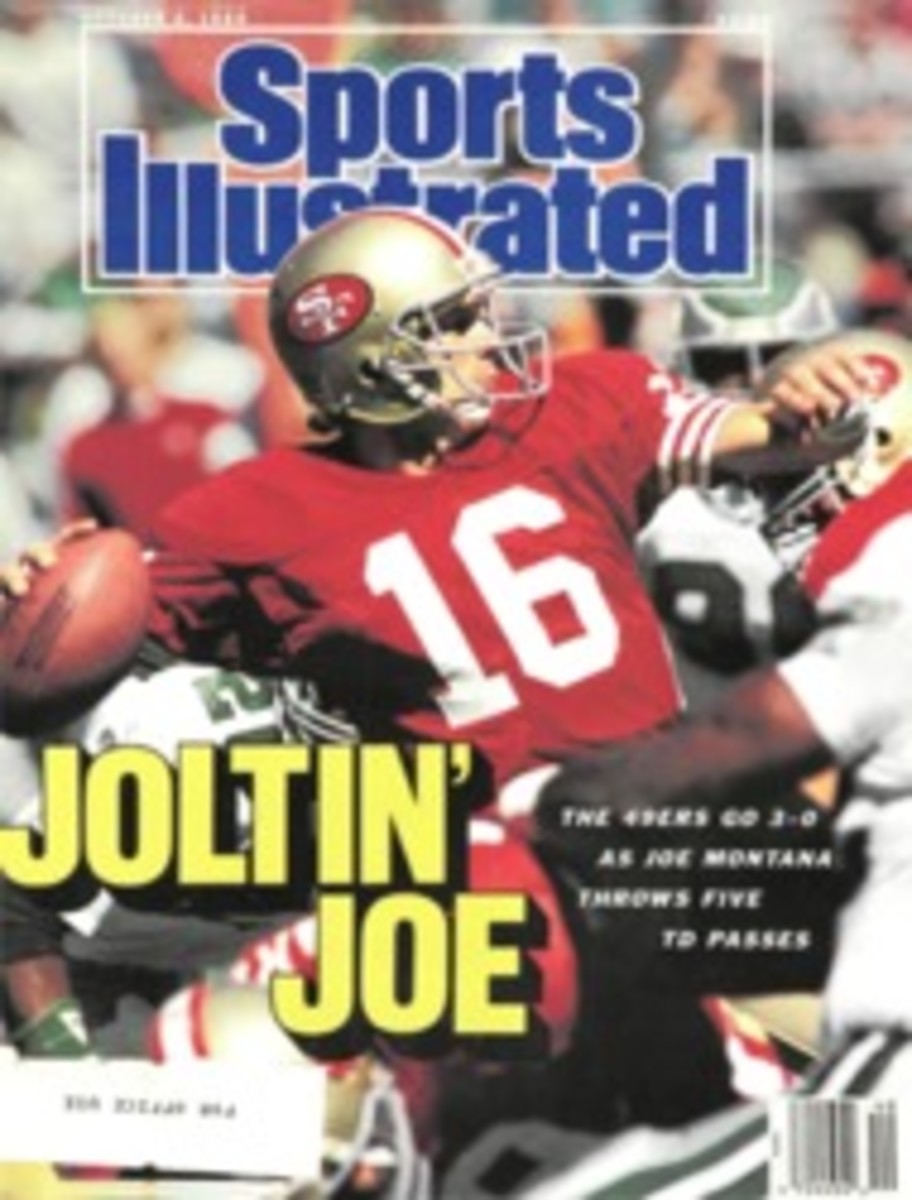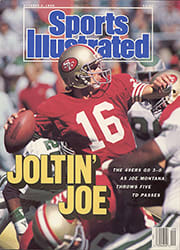
DON LARSEN HAD THE PERFECT REMEDY FOR A COUSIN'S WOES
From time to time during the spring of 1956, postcards and packages would arrive at my house, first from Florida and then from various American League cities. They were sent to me by my second cousin, Yankee pitcher Don Larsen. One postcard that I still have bears a Chicago postmark dated May 17: "Here's luck on your baseball. I'm rooting for you and maybe I'll get a chance to see you soon. Don Larsen." On the other side was a black-and-white photo of my great-uncle Jim's mammoth son. He looked, as he did in the pictures on his baseball cards, as though he had been shot and stuffed while in the act of following through on a pitch.
On May 31, my ninth birthday, I opened a present wrapped in brown paper. It was my cousin's Yankee hat. Stains around the sweatband and a bent bill certified that it was genuine. I brought it to school the next day and pointed out that it was just like Mickey Mantle's hat. Everyone tried it on, and then it was passed back to me. "Won't make you play any better," someone finally said. "Anyway, he's no good."
"You got a cousin on the Yankees?" I demanded.
"I don't need one," came the reply.
The truth was that Don Larsen and I were both in the middle of hard baseball times. The winter before, I had moved to Speedway, Ind., from South Bend, where nobody in my neighborhood or at my school had played baseball. In Speedway, baseball was everything: A boy's caste was established by his performance in the games we played during recess. I had never held a bat. It took one swing for my classmates to recognize an untouchable.
My dad bought me a bat and a ball, but he couldn't help me put the two together. He had never played baseball either. Sensing my desperation, one morning before school my dad offered me what must have been the only three words of advice that he could think of. "Never stop running," he said firmly. A few hours later at recess, I hit a thrown ball for the first time, causing it to roll back to the pitcher. With my father's words pounding in my ears, I raced head down around the bases and slid into home as my schoolmates doubled up with laughter.
Larsen wasn't doing much better. With Baltimore in 1954, "Big Don," as the bubble gum company called him, won three games and lost 21. It was the worst record I or any of my new friends had ever seen on a baseball card. "It is safe to say," the gum people noted dryly, "that Big Don would have won more games with a better hitting team behind him." The strange thing was that after doing so poorly, Larsen had been traded to the Yankees, baseball's best team.
Privately, I had to agree with my classmates, who kept saying that no one in his right mind would keep a Don Larsen baseball card if he could get rid of it. I remember that of all of the Larsenalia I showed them in the spring of 1956, the item that made the biggest impression was a clipping from The Indianapolis Star—my new Bible—reporting that my cousin, whom the Star called "Playboy Don Larsen," had wrapped a car around a telephone pole as dawn began to color the Florida sky. Everyone admired a quote in the story from the Yankee manager, Casey Stengel. "The only thing Larsen fears," Stengel said, "is sleep."
I first met my cousin in July 1956, when our family drove from Indianapolis to Chicago to see the Yankees play the White Sox. We left early in the morning so that I could get there in time to see Mantle take batting practice. I sat alone in the backseat, absorbed in a Baseball Digest. One article, about Enos Slaughter scoring from first on a single in the 1946 World Series, had a sentence that read, "Slide, you bastard, slide!"
"What's a bastard?" I asked my mother. My father nearly drove the car off the road. The sky began to turn gray near Lafayette and then black as we passed through Gary. It was pouring when we reached Chicago.
The game was rained out. I stopped crying only after my dad sprinted back from a phone booth, my copy of The Sporting News covering his head, to tell us that we were going to meet Don at Chicago's Del Prado Hotel, where the Yankees were staying. We went in through the revolving door, and there he was, by far the largest human I had ever seen. He wore a loose-fitting brown suit with pants whose creases seemed to converge somewhere over my head. After he greeted my dad—I was impressed that he clearly recognized my father—I offered him my hand. Instead, he wrapped his arms around me and pulled my head into his thigh. He asked me if I would like to meet a few of the Yankees.
That day remains one of the best of my life. Johnny Kucks, nearly as big as Don, hugged me too. Whitey Ford cautioned me against trying to throw curves too soon. Don spotted Stengel holding court with a cluster of baseball writers in a corner of the lobby. Don shoved me toward him. "Go over there by yourself," he said. "Tell him you're my cousin." I walked across the room, heart hammering. "You're Larsen's cousin?" asked Stengel, and he grabbed my arm, drawing me close.
"I just finished reading your biography," I told him.
"Lies, all lies!" he said. "Written by guys like these. Take a good look at these faces. Let me tell you one thing, kid. Don't grow up to be a writer." And he signed my autograph book.
Mantle was standing by himself at the cigar stand, flipping through a magazine. For a moment I couldn't move, and then I started toward him. Don held me back. In mid-1956, Mantle was on pace to break Babe Ruth's 60-homer mark. He was among the most hounded people in the world. Don wouldn't let me disturb him. "Give me your book and wait here," said Don. They spoke, and without looking up, Mantle scribbled his name in my book. Afterwards we lunched with Ryne Duren, whom Don called "Froggie." Yogi Berra walked by and rubbed my head. Weeks later, I washed it again.
Oct. 8, 1956. Everything changed for both of us on that day. I was now in fourth grade, still trying to hit a baseball, one of the only kids my age who had been cut from Little League the previous summer. Don, too, had had a rocky spring, but he pitched well during August and September and finished the regular season with an 11-5 record.
He started the second game of the World Series against the Brooklyn Dodgers. The Yankees were leading 6-1, but Stengel removed him in the bottom of the second after the Dodgers scored one run and loaded the bases. The Star reported that Larsen was furious. It said that Larsen was in Stengel's doghouse and that he probably wouldn't pitch again in the Series.
Our school had a 50-minute lunch period, and I lived a mile away. My mother did her best to make sure that I could watch at least a half hour of each World Series game during my grade school years. She prepared my lunch—chicken noodle soup and liver sausage on crackers—and placed it on a tray in front of the set. Then she rode my bike halfway to school. When the lunch bell rang, I sprinted to meet the bike and leaped on, pony-express style, and wheeled for home with my mom on foot in pursuit.
When I got home for the fifth game, Don was pitching against the Dodgers' Sal Maglie in the second inning with the score tied 0-0. I watched Mantle blast a home run in the fourth and make a wonderful running catch of a Gil Hodges drive in the fifth. My cousin was pitching well, but I had no idea how well, and the announcers were not saying.
I begged my mother to let me stay home, but she knew that everyone in the school knew I had been healthy enough to sprint home. For her, the decision wasn't even close.
I went back to school unable to think of anything but the game. Most Series games ended after school let out at 3:30, so I would go down to the boiler room and listen to the end of the game with one of the janitors. But that day our classroom door opened at 3:00 sharp, and the principal, Mr. Lincoln C. Northcott, entered. He stepped to the front of the room and asked our teacher, Miss Hazel Smith, if he could be permitted to speak to the class. I remember his every word, where I was seated and the hot feeling on my cheeks.
"Something special has happened," he said. "It is about the World Series. The Yankees won today." Groans and cheers. "But it's more than that. Phil's cousin has pitched the first perfect game in the history of the World Series. Who knows what a perfect game is?"
I knew, but I couldn't move. Someone said, "It's a no-hitter."
"No," said Mr. Northcott, "it's even better. No Dodger even got to first base. Don Larsen didn't give up a hit. He didn't walk anybody, and the Yankees didn't make any errors. Phil's cousin got every single batter out. They are saying it might be the best game anyone ever pitched. Congratulations, Phil."
As Miss Smith beamed, my classmates began to applaud. Then, because no one stopped them, they gathered around my desk to pump my hand and pound my back. In the weeks that followed, glory was mine. When Don appeared on the cover of a magazine with a blonde starlet named Diana Dors balanced on his thigh, a part of the victory fell to me.
I never made the big leagues. In fact, I topped out as a 15-year-old Pony Leaguer, wearing the enormous Spalding glove that my cousin sent me in 1957 for my birthday. I will go to my grave terrified of anything that looks like a fastball.
In truth, the best day I ever had in baseball was Oct. 8, 1956. I still have scrapbooks full of clippings about the perfect game and its aftermath: Don drinking with Jackie Gleason, Don dining with nightclub singer Audrey Armstrong, Don in his Series MVP Corvette, Don on a Bob Hope special. "It's amazing," he said in a story in the Star a few weeks after the game. "Not long ago I was a nobody, and now everyone wants me."
In the fall of 1956, when I was having trouble hitting and the game of baseball was all the world to me, I knew exactly what he meant.
TWO PHOTOS
Among the author's Larsenalia is a postcard from the pitcher with his picture on the front.
PHOTO
Big Don met his nine-year-old cousin when the author and his parents drove to Chicago.
PHOTO
ARTHUR RICKERBY/UPI/BETTMANN
Oct. 8, 1956: With Billy Martin at second, Larsen threw the last pitch of his perfect game and then was congratulated by Berra.
PHOTO
HERB SCHARFMAN/INTERNATIONAL NEWSPHOTOS
[See caption above.]
Phillip Hoose's latest book is "Necessities: Racial Barriers in American Sports."

